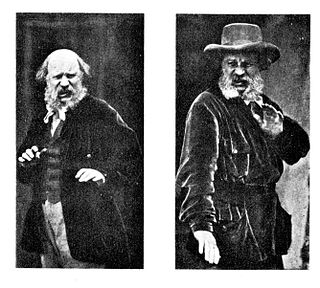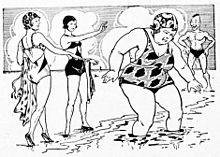
The fat acceptance movement is a social movement which seeks to eliminate the social stigma of obesity. Areas of contention include the aesthetic, legal, and medical approaches to fat people.
An eating disorder is a mental disorder defined by abnormal eating behaviors that adversely affect a person's physical or mental health. Types of eating disorders include binge eating disorder, where the patient eats a large amount in a short period of time; anorexia nervosa, where the person has an intense fear of gaining weight and restricts food or overexercises to manage this fear; bulimia nervosa, where individuals eat a large quantity (binging) then try to rid themselves of the food (purging); pica, where the patient eats non-food items; rumination syndrome, where the patient regurgitates undigested or minimally digested food; avoidant/restrictive food intake disorder (ARFID), where people have a reduced or selective food intake due to some psychological reasons; and a group of other specified feeding or eating disorders. Anxiety disorders, depression and substance abuse are common among people with eating disorders. These disorders do not include obesity. People often experience comorbidity between an eating disorder and OCD. It is estimated 20–60% of patients with an ED have a history of OCD.
Binge eating disorder (BED) is an eating disorder characterized by frequent and recurrent binge eating episodes with associated negative psychological and social problems, but without the compensatory behaviors common to bulimia nervosa, OSFED, or the binge-purge subtype of anorexia nervosa.
Binge eating is a pattern of disordered eating which consists of episodes of uncontrollable eating. It is a common symptom of eating disorders such as binge eating disorder and bulimia nervosa. During such binges, a person rapidly consumes an excessive quantity of food. A diagnosis of binge eating is associated with feelings of loss of control. Binge eating disorder is also linked with being overweight and obesity.

Body dysmorphic disorder (BDD), also known in some contexts as dysmorphophobia, is a mental disorder defined by an overwhelming preoccupation with a perceived flaw in one's physical appearance. In BDD's delusional variant, the flaw is imagined. When an actual visible difference exists, its importance is disproportionately magnified in the mind of the individual. Whether the physical issue is real or imagined, ruminations concerning this perceived defect become pervasive and intrusive, consuming substantial mental bandwidth for extended periods each day. This excessive preoccupation not only induces severe emotional distress but also disrupts daily functioning and activities. The DSM-5 places BDD within the obsessive–compulsive spectrum, distinguishing it from disorders such as anorexia nervosa.
Trichophagia is a form of disordered eating in which persons with the disorder suck on, chew, swallow, or otherwise eat hair. The term is derived from ancient Greek θρίξ, thrix ("hair") and φαγεῖν, phagein. Tricho-phagy refers only to the chewing of hair, whereas tricho-phagia is ingestion of hair, but many texts refer to both habits as just trichophagia. It is considered a chronic psychiatric disorder of impulse control. Trichophagia belongs to a subset of pica disorders and is often associated with trichotillomania, the compulsive pulling out of ones own hair. People with trichotillomania often also have trichophagia, with estimates ranging from 48-58% having an oral habit such as biting or chewing, and 4-20% actually swallowing and ingesting their hair. Extreme cases have been reported in which patients consume hair found in the surrounding environment, including the hair of other people and animals. In an even smaller subset of people with trichotillomania, their trichophagia can become so severe that they develop a hair ball. Termed a trichobezoar, these masses can be benign, or cause significant health concerns and require emergency surgery to remove them. Rapunzel syndrome is a further complicaiton whereby the hair ball extends past the stomach and can cause blockages of gastrointestinal system.

Body image is a person's thoughts, feelings and perception of the aesthetics or sexual attractiveness of their own body. The concept of body image is used in several disciplines, including neuroscience, psychology, medicine, psychiatry, psychoanalysis, philosophy, cultural and feminist studies; the media also often uses the term. Across these disciplines, there is no single consensus definition, but broadly speaking, body image consists of the ways people view themselves; their memories, experiences, assumptions, and comparisons about their appearances; and their overall attitudes towards their respective heights, shapes, and weights—all of which are shaped by prevalent social and cultural ideals.
Disordered eating describes a variety of abnormal eating behaviors that, by themselves, do not warrant diagnosis of an eating disorder.
A food addiction or eating addiction is any behavioral addiction that is primarily characterized by the compulsive consumption of palatable food items which markedly activate the reward system in humans and other animals despite adverse consequences.

Disgust is an emotional response of rejection or revulsion to something potentially contagious or something considered offensive, distasteful or unpleasant. In The Expression of the Emotions in Man and Animals, Charles Darwin wrote that disgust is a sensation that refers to something revolting. Disgust is experienced primarily in relation to the sense of taste, and secondarily to anything which causes a similar feeling by sense of smell, touch, or vision. Musically sensitive people may even be disgusted by the cacophony of inharmonious sounds. Research has continually proven a relationship between disgust and anxiety disorders such as arachnophobia, blood-injection-injury type phobias, and contamination fear related obsessive–compulsive disorder.
Wilson-Turner syndrome (WTS), also known as mental retardation X linked syndromic 6 (MRXS6), and mental retardation X linked with gynecomastia and obesity is a congenital condition characterized by intellectual disability and associated with childhood-onset obesity. It is found to be linked to the X chromosome and caused by a mutation in the HDAC8 gene, which is located on the q arm at locus 13.1. Individuals with Wilson–Turner syndrome have a spectrum of physical characteristics including dysmorphic facial features, hypogonadism, and short stature. Females generally have milder phenotypes than males. This disorder affects all demographics equally and is seen in less than one in one million people.
Puberty is the process of physical changes through which a child's body matures into an adult body capable of sexual reproduction. It is initiated by hormonal signals from the brain to the gonads: the ovaries in a female, the testicles in a male. In response to the signals, the gonads produce hormones that stimulate libido and the growth, function, and transformation of the brain, bones, muscle, blood, skin, hair, breasts, and sex organs. Physical growth—height and weight—accelerates in the first half of puberty and is completed when an adult body has been developed. Before puberty, the external sex organs, known as primary sexual characteristics, are sex characteristics that distinguish males and females. Puberty leads to sexual dimorphism through the development of the secondary sex characteristics, which further distinguish the sexes.

Anorexia nervosa (AN), often referred to simply as anorexia, is an eating disorder characterized by food restriction, body image disturbance, fear of gaining weight, and an overpowering desire to be thin.
Social stigma of obesity is broadly defined as bias or discriminatory behaviors targeted at overweight and obese individuals because of their weight and a high body fat percentage. Such social stigmas can span one's entire life, as long as excess weight is present, starting from a young age and lasting into adulthood. Studies also indicate overweight and obese individuals experience higher levels of stigma compared to other people.
Body image is a complex construct, often used in the clinical context of describing a patient's cognitive perception of their own body. The medical concept began with the work of the Austrian neuropsychiatrist and psychoanalyst Paul Schilder, described in his book The Image and Appearance of the Human Body first published in 1935. The term “body image” was officially introduced by Schilder himself and his widely used definition is: “body image is the picture of our own body we form in our mind, that is to say the way in which the body appears to ourselves”. In research with the term “body image” we currently refer to a conscious mental representation of one’s own body, which involves affects, attitudes, perceptual components and cognition. On the contrary the term “body schema” was initially used to describe an unconscious body mental representation fundamental for action. Keizer and colleagues (2013) suggest the following definition: “[body schema is] an unconscious, sensorimotor, representation of the body that is invoked in action. In light of recent scientific developments regarding the multisensory integration of body sensations, the distinction between body image and body schema appears simplistic and probably no longer useful for scientific research and clinical purposes.
Body shape refers to the many physical attributes of the human body that make up its appearance, including size and countenance. Body shape has come to imply not only sexual/reproductive ability, but wellness and fitness. In the West, slenderness is associated with happiness, success, youth, and social acceptability. Being overweight is associated with laziness. The media promote a weight-conscious standard for women more often than for men. Deviance from these norms result in social consequences. The media perpetuate this ideal in various ways, particularly glorifying and focusing on thin actors and actresses, models, and other public figures while avoiding the use or image of overweight individuals. This thin ideal represents less than 15% of the American population.
The feminine beauty ideal is a specific set of beauty standards regarding traits that are ingrained in women throughout their lives and from a young age to increase their perceived physical attractiveness. It is a phenomenon experienced by many women in the world, though the traits change over time and vary in country and culture.

African Americans and their skin color and hair were once considered unattractive by white people. Black women and their bodies have been devalued and rejected by white ideal beauty standards.

Body positivity is a social movement that promotes a positive view of all bodies, regardless of size, shape, skin tone, gender, and physical abilities. Proponents focus on the appreciation of the functionality and health of the human body, instead of its physiological appearance.
Body image disturbance (BID) is a common symptom in patients with eating disorders and is characterized by an altered perception of one's own body.






